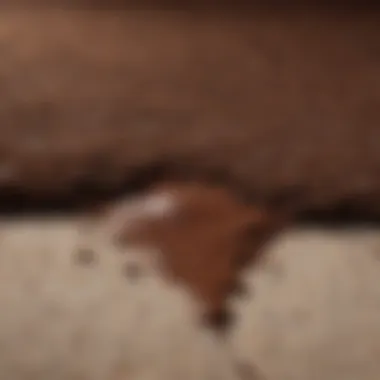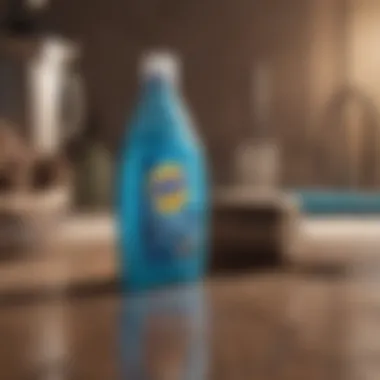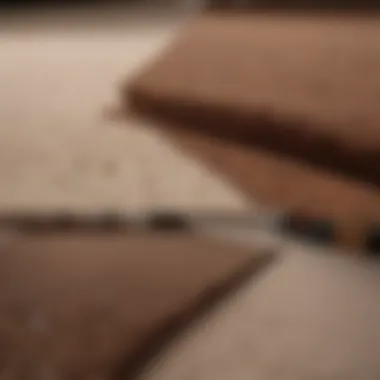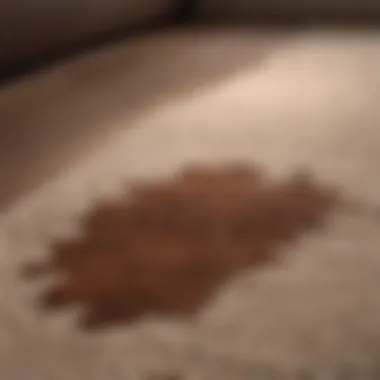Expert Tips for Removing Chocolate Stains from Carpet


Intro
Chocolate stains can seem like a nightmare for any homeowner or design aficionado. These stubborn marks can threaten the elegance and functionality of a well-chosen carpet. Knowing how to address chocolate stains effectively is crucial not only for aesthetic reasons but also for maintaining the longevity of carpet fibers. In this article, we will explore various methods for removing chocolate stains, emphasizing the careful techniques necessary to avoid further damage to your carpet while restoring its appeal. Our objective is to equip you with practical strategies and cleaning solutions, ensuring that your living spaces remain visually appealing and inviting.
Design Inspiration
Current Interior Design Trends
In today's design landscape, there is a growing emphasis on functionality paired with warmth and comfort. Neutral and earthy tones are highly regarded, with textures playing a vital role in creating a cozy atmosphere. Selecting carpets that complement these trends—like soft pastels or natural hues—can enhance a space's appeal. However, these choices also highlight the visibility of stains, particularly chocolate, which necessitates immediate and effective cleaning techniques.
Color Palettes and Their Effects
Color palettes can significantly influence the perception of a space. Dark carpets can absorb stains while light-colored carpets accentuate them. When selecting carpets, it’s essential to consider how chocolate stains may interact with the chosen color scheme. If you favor darker tones, warm shades can create an inviting feel but may require specific cleaning solutions to maintain their integrity. Conversely, lighter carpets might necessitate more frequent cleaning but can make spaces feel open and airy.
Effective Chocolate Stain Removal Techniques
Immediate Actions
When a chocolate stain occurs, prompt action is critical. Following these steps can mitigate the situation before it becomes permanent:
- Scrape Gently: Using a dull knife, carefully scrape away solid chocolate residue without pushing it deeper into the carpet fibers.
- Blot Excess: Take a clean, dry cloth or paper towel to blot the area. Do not rub, as this may spread the stain.
- Apply Cold Water: Dampen a cloth with cold water and continue to blot the stain. This can help dissolve some of the chocolate's stickiness.
Long-Term Solutions
For set-in stains, more robust cleaning methods are necessary. Consider using the following solutions:
- Dish Soap and Water: Mix a few drops of mild dish soap with cold water. Apply this mixture to the stain using a cloth, blotting as needed.
- Vinegar Solution: Combine equal parts white vinegar and water. This solution can help neutralize the stain's color, making it easier to remove.
- Commercial Carpet Cleaners: Products like Resolve Carpet Stain Remover can be effective for chocolate stains. Always test in an inconspicuous area first.
Always prioritize testing any cleaning solution on a small, hidden part of the carpet to ensure it does not cause damage or discoloration.
Finale
Understanding how to effectively remove chocolate stains from carpets is essential for maintaining the beauty of your spaces. This article highlights the importance of quick action and appropriate cleaning techniques. Ultimately, whether one is an avid entertainer or a meticulous homeowner, being equipped with this knowledge can save both time and effort, ensuring carpets remain in excellent condition for many years to come.
Understanding Chocolate Stains
Understanding chocolate stains is crucial for effectively dealing with them. Homeowners, interior design enthusiasts, and party hosts may find themselves struggling with chocolate spills, especially during gatherings. Chocolate contains fats and sugars that can bind to carpet fibers, making the removal process more challenging than other types of stains. Knowing the nature of these stains allows one to choose the appropriate techniques and cleaning solutions.
Chemical Composition of Chocolate
Chocolate is primarily composed of cocoa solids, cocoa butter, sugar, and often milk solids. The cocoa butter, a fat, can leave an oily residue on carpet fibers. This residue tends to absorb into the fabric, leading to a stubborn stain if not treated promptly. Additionally, the sugar content can attract dirt, further complicating the cleaning process. Understanding these components is key in selecting the right cleaning method to dissolve and lift the stain from the carpet.
Behavior of Chocolate on Carpets
When chocolate comes into contact with carpet, its behavior is dictated by its physical state—solid or melted. Melted chocolate can seep deeper into the fibers, creating a larger, more challenging stain. If the chocolate is still semi-solid, it’s possible to gently scrape off the excess before it adheres too strongly to the carpet. The carpet's material also affects how easily the stain can be removed. Natural fibers like wool may absorb stains differently than synthetic fibers. Recognizing these factors is essential in determining the most effective removal techniques.
Initial Assessment
Before attempting to remove chocolate stains from carpet, an initial assessment is essential. This step is not just a formality; it helps in determining the most effective removal strategy based on specific carpet characteristics and the nature of the stain. Appropriately assessing the situation can lead to significant time savings, as well as reducing the risk of damaging the carpet further.
Identifying the Type of Carpet
Understanding the type of carpet you are dealing with is crucial. Different materials react differently to cleaning solutions and techniques. Common carpet types include nylon, polyester, wool, and olefin. Each has its own set of characteristics:


- Nylon: This synthetic fiber is durable and resists stains. However, it can be sensitive to high heat and certain cleaning chemicals.
- Polyester: Known for its vibrant colors and affordability, polyester is generally resistant to stains but may absorb oils more easily.
- Wool: A natural fiber that is soft and luxurious but can be prone to shrinking when exposed to water or heat.
- Olefin: Often used in outdoor carpets, olefin is stain-resistant and colorfast but can be damaged by heat or harsh chemicals.
To accurately identify the carpet type, check the fiber content label if available. If not, tactile inspection can help; for instance, nylon feels smoother than polyester. Understanding the material lays a foundation for selecting the right cleaning approach.
Evaluating the Stain's Age and Size
Next, it is essential to evaluate how long the chocolate stain has been present and its size.
- Age of the stain: Fresh stains are generally easier to remove than older ones. Chocolate stains, when dry, can become set, making them much more difficult to eliminate. If the stain is still wet, immediate action is necessary to prevent it from setting.
- Size of the stain: Large stains may require more extensive cleaning solutions or methods, while smaller spots can often be treated with simple blotting techniques.
To determine the stain's age, examine its surface. If it appears shiny or slightly tacky, it may still be wet. In contrast, a dull and hardened stain indicates it has set. Size evaluation will inform whether a targeted approach or a more comprehensive cleaning solution is needed.
"Early intervention is key when dealing with stains. Assessing the type and age provides direction for effective cleaning."
By carefully identifying the type of carpet and assessing the stain's characteristics, homeowners can take informed actions to remove chocolate stains effectively, preserving the integrity and appearance of their carpets.
Immediate Response Techniques
Immediate response techniques are crucial when it comes to dealing with chocolate stains on carpets. Speedy action can prevent the stain from settling deeper into the fibers, making it harder to remove later. These techniques focus on removing excess chocolate and blottg the stain effectively, minimizing further damage. In this section, we analyze specific methods to ensure the best outcome in chocolate stain removal.
Removing Excess Chocolate
Gently scraping with a dull knife
Gently scraping with a dull knife is an essential first step in the chocolate stain removal process. The key characteristic of this technique lies in its ability to lift chocolate off the carpet surface without pushing it deeper into the fibers. It is a beneficial choice for this article, as it allows homeowners to act swiftly before the stain sets. The unique feature of using a dull knife is that it minimizes the risk of damaging the carpet fibers while effectively removing as much chocolate as possible without spreading it. However, caution is necessary; if one scrapes too aggressively, it may cause fraying or other damage to the carpet.
Using a vacuum for small particles
Using a vacuum for small particles is another important aspect of the immediate response techniques. This method helps to remove tiny bits of chocolate that may have crumbled and fallen into the carpet. The key characteristic of this approach is its efficiency; a vacuum is designed to suck away particles quickly and effectively. This is a popular choice for this article because it can clean up residual chocolate without any physical contact, reducing the chance of spreading the stain. One unique feature of this technique is that most household vacuums are equipped with attachments that can target dirt and debris within carpet fibers. Nonetheless, vacuums may struggle with larger chocolate pieces, making it essential to combine this method with scraping to achieve optimal results.
Blotting the Stain
Choosing the right absorbent material
Choosing the right absorbent material is vital in the blotting process of chocolate stains. The ability of the material to soak up the chocolate and the cleaning solution used can significantly impact the effectiveness of the stain removal. Towels made from cotton or microfiber are often recommended because of their high absorbent capacity. This characteristic makes them a beneficial choice as they can trap liquid effectively, aiding in lifting the stain from the carpet. A unique feature of cotton towels is their softness, which helps in preventing further damage to the carpet fibers compared to rougher materials. However, using the wrong material could lead to spreading the stain instead of absorbing it.
Effective blotting technique
Effective blotting technique plays a vital role in removing chocolate stains without causing further damage. This technique focuses on using a gentle dabbing motion rather than rubbing, which can push the stain deeper into the fibers. The key characteristic of a proper blotting technique is its ability to absorb the liquid without spreading it, making it easier to lift the stain gradually. This technique is a preferred method as it is non-intrusive and helps maintain carpet integrity while treating the stain. The advantage here is clear: it focuses on containment rather than exacerbation of the problem. However, care must be taken not to overcrowd the area being blotted, as this can lead to pooling and inefficiency in stain removal.
Cleaning Solutions
Cleaning solutions are crucial in managing chocolate stains on carpets. The right cleaner can effectively penetrate the fibers, neutralizing the stain without damaging the carpet. This section focuses on two categories of cleaning solutions: commercial carpet cleaners and homemade cleaning solutions. Both have their merits, and understanding their differences is important for homeowners and care enthusiasts alike.
Commercial Carpet Cleaners
Commercial carpet cleaners come pre-formulated and are designed to tackle tough stains, including chocolate. Their strength lies in their specialized chemical composition, which is effective for various types of stains.
Types and their effectiveness
Commercial cleaners can be classified into different types based on their formulations. These include enzymatic cleaners, solvent-based cleaners, and foam carpet cleaners. Enzymatic cleaners work by breaking down the organic matter found in stains, while solvent-based options dissolve sticky residues. Foam cleaners can lift stains with their frothy action, making them popular for many users.
The effectiveness of these cleaners varies depending on the stain's composition and the carpet material. Enzymatic cleaners, for instance, are particularly effective for biological stains but may require longer exposure time to be effective. On the other hand, solvent-based cleaners work quickly but can sometimes discolor certain carpet types. It’s essential to choose the right type based on the specific needs of your carpet and the nature of the stain.
Application methods


Applying commercial cleaners properly emphasizes their effectiveness. Most products will come with guidelines for application, but general methods typically include spraying directly onto the stain and allowing it to sit before blotting. Some products may require scrubbing with a brush, while others may need a vacuum to extract the cleaner.
A key characteristic of commercial carpet cleaners is their convenience. They are easy to use and can provide quick results when applied correctly. However, it’s vital to follow the manufacturer’s instructions to avoid potential issues like residue buildup or carpet damage from improper use.
Homemade Cleaning Solutions
Homemade cleaning solutions offer an alternative to commercial products, often being cost-effective and environmentally friendly. Many homeowners prefer them due to their accessibility and simplicity, using common household items to tackle stains.
Simple soap-and-water mixture
A simple soap-and-water mixture is often the first choice for stains. This method typically involves mixing a mild detergent with warm water. The solution is gentle yet effective for lifting chocolate stains.
The appeal of this method lies in its simplicity. Most households have soap and water readily available, making it a quick go-to option. Moreover, it is less likely to damage the fibers of the carpet compared to harsher chemicals. However, this method may require several applications to fully remove stubborn stains.
Baking soda and vinegar method
Another popular homemade solution involves baking soda and vinegar. This combination creates a powerful cleaning reaction that can lift and neutralize stains. The abrasiveness of baking soda helps to scrub the surface, while vinegar acts as a natural disinfectant.
This method is beneficial not only for chocolate stains but also for odors associated with them. The unique feature of baking soda and vinegar is their natural ingredients, which offers a safer alternative compared to commercial cleaners. However, care must be taken not to overuse vinegar, as it can affect certain carpet materials if left unchecked.
Using homemade solutions is cost-effective and reduces reliance on chemicals, promoting a safer cleaning environment.
In summary, when addressing chocolate stains on carpets, choosing the appropriate cleaning solution is essential. Both commercial and homemade options provide effective approaches. Understanding the characteristics, applications, and potential drawbacks of each method can lead to successful stain removal while maintaining the carpet's integrity.
Step-by-Step Cleaning Process
The removal of chocolate stains from carpets requires a thoughtful and structured approach. The step-by-step cleaning process ensures that each action taken is deliberate, minimizing the risk of further damage to the carpet fibers. Understanding this process allows homeowners and interior design enthusiasts to maintain the integrity of their carpets while achieving satisfactory results. In the following sections, key elements of this cleaning procedure will be highlighted, emphasizing their benefits and considerations in effectively dealing with chocolate stains.
Preparing the Area
Clearing the room
Clearing the room is an essential first step in the cleaning process. This action facilitates easy movement and ensures that all cleaning efforts are focused on the stained carpet area. An uncluttered space allows for better access to the stain, making the removal process more efficient.
One significant characteristic of clearing the room is its ability to prevent accidents or inadvertent damage. With furniture and other obstacles out of the way, tools and cleaning agents can be applied without hindrance. A clean working area also fosters concentration, which can improve the effectiveness of cleaning efforts. However, this process may take some time, so it is vital to plan accordingly, especially in busy households.
Gathering necessary supplies
Gathering necessary supplies is another critical aspect of this process. This includes locating all essential cleaning materials before starting the stain removal. Supplies might consist of blotting paper, cleaning solutions, vacuum cleaners, and even gloves.
Having all tools available at the start enhances the efficiency of the cleaning process. A distinctive characteristic of this preparation stage is that it enables one to take inventory of what is needed. This preemptive action could prevent interruptions once the cleaning begins, allowing for a more streamlined approach. However, gathering supplies can take effort and might require one to do research on the most effective cleaning products for chocolate stains.
Applying Cleaning Solution
Testing on a hidden area
Testing on a hidden area is a precautionary step when applying any cleaning solution. This practice helps to ensure that the chosen cleaning agent does not cause additional damage or discoloration to the carpet. Selecting a small, inconspicuous spot prevents potential large-scale issues while validating the product's effectiveness.
The necessity of this step cannot be overstated. It serves as a safeguard against irreversible harm, which is crucial in maintaining the value of the carpet. A drawback might be that it adds extra time to the cleaning process, but the benefits outweigh this minor inconvenience.
Applying with precision
Applying with precision relates directly to the method employed when using cleaning solutions. This step requires careful adherence to instructions, ensuring that the solution is applied evenly and specifically to the stained area. Effective application minimizes the risk of oversaturation, which could lead to further issues like mold or mildew.


Focusing on precision fosters positive outcomes in stain removal. A major advantage is the promotion of thorough cleaning without unnecessary product waste. Still, it might require some attention to detail and practice to develop a proper application technique that does not compromise the carpet's fabric.
Post-Cleaning Care
Rinsing with water
Rinsing with water is a crucial final step in the cleaning process. After cleaning solution has been applied and the stain is gone, rinsing helps to remove any leftover residues. This action maintains the carpet's cleanliness and avoids attracting dirt back to the area.
One important aspect of rinsing is its ability to enhance the overall appearance of the carpet. It is beneficial because it extends the life of both the cleaning solution and the carpet itself. However, care must be taken to not oversaturate the carpet during this step.
Proper drying techniques
Proper drying techniques round out the cleaning process. Drying is essential to prevent mildew and unpleasant odors from developing. Using fans or open windows can help facilitate the drying; however, the right method ensures that moisture is removed effectively without causing damage.
The key feature of proper drying is that it allows the fiber to maintain its structure and appearance. Effective drying is a beneficial choice as it contributes to the longevity of the carpet. Neglecting this step could lead to issues that compromise the cleanliness achieved during the stain removal process.
"Successful stain removal relies heavily on understanding the right techniques and methods to adopt."
By following these clear steps, homeowners can effectively tackle chocolate stains with confidence.
Preventative Measures
Preventing chocolate stains on carpet is essential for maintaining its condition and appearance. Taking proactive steps can significantly reduce the likelihood of such stains becoming a problem in the first place. This section covers the importance of adopting preventative measures, focusing on two primary areas: protective treatments and educating household members.
Protective Treatments for Carpet
Applying protective treatments to your carpet can prove beneficial in many ways. These treatments often form a barrier that resists dirt, spills, and stains. They can be found in various products, including stain repellents and carpet protectors, which are often available at home improvement stores or online retailers.
- Types of Treatments: Some treatments are applied as sprays, while others are incorporated into the carpet manufacturing process. Some popular options include Scotchgard and Teflon.
- Application Process: When applying a protective treatment, follow the manufacturer’s instructions closely. Ensure the carpet is clean and dry before application. Typically, users should spray it evenly across the carpet and allow it to dry completely.
The benefits of these treatments are noticeable. They can prolong the life of your carpet by minimizing the absorption of stains, making future cleaning easier. However, homeowners must remember that no treatment can guarantee complete stain-proofing. Therefore, even with a treatment applied, it is still imperative to act quickly if a spill occurs.
Educating Household Members
Education plays a critical role in preventing stains from becoming a lasting issue. Informing everyone who uses the space about the importance of careful consumption of chocolate around the carpet can lead to fewer accidents.
- Set Clear Rules: Establish guidelines for areas where food consumption is allowed, particularly in rooms with carpeting.
- Discuss Immediate Responses: Teach household members the correct initial response when a spill occurs. This incorporates gently scraping off excess chocolate and stopping further spreading by blotting with the right material.
- Share Cleaning Knowledge: Create awareness about the cleaning solutions available and the step-by-step processes that should be followed to treat stains.
By equipping everyone in the household with information regarding the dos and don’ts of food handling near carpets, the risk of chocolate stains can significantly decrease. This practice not only fosters a more responsible environment but also helps in preserving the aesthetics and functionality of the carpet.
"Prevention is always better than cure; a stitch in time saves nine."
In summary, focusing on protective treatments and educating household members about caring for carpets can greatly enhance the longevity and appearance of your carpet. This dual approach lays the groundwork for maintaining cleanliness and beauty in your living space.
When to Seek Professional Help
Dealing with chocolate stains on carpets can be a complex task. While many cleaning methods exist for homeowners to try, there are times when it is wise to involve professional assistance. Understanding when to turn to experts can save more time and potentially reduce costs associated with further damage.
Signs of Permanent Damage
Certain indicators can reveal whether a chocolate stain has caused permanent damage to the carpet.
- Fading or discoloration: If blotting does not lift the stain, it may begin to alter the color of the carpet fibers. This can signal that the chocolate has seeped deep into the material.
- Textural changes: When the carpet feels sticky or grimy to the touch, it suggests the stain’s residue has altered its original texture, making area cleaning ineffective.
- Lingering odors: A smell associated with the chocolate, especially if it has molded, hints that the substance has not only stained but also compromised the carpet’s integrity over time.
- Stains reappearing after cleaning: If the stain returns after cleaning attempts, it means the residue remain trapped within the fibers. This often warrants professional intervention to extract the stain completely.
Recognizing these signs early can prevent more serious and costly carpet rehabilitation efforts later.
Choosing a Professional Cleaning Service
If it’s determined that professional help is needed, selecting the right service is crucial. Here are a few key considerations for doing so:
- Experience in stain removal: Look for companies that specialize in chocolate stain removal or carpet cleaning. Firms with a track record in handling similar situations tend to employ effective techniques.
- Investigate reviews and testimonials: Online reviews from previous clients can provide insight into the reputation of the service. Websites such as reddit.com can offer community feedback that is very helpful.
- Methods and products used: It is vital to inquire about the cleaning methods and solutions they employ. Eco-friendly products may be preferable for your home environment.
- Pricing transparency: Ensure the cleaning service provides a clear estimate. Hidden fees can lead to surprises that complicate decisions.
- Guarantee of service: A reputable company often provides a satisfaction guarantee. This can be a sign of their confidence in effectively removing the stain.















